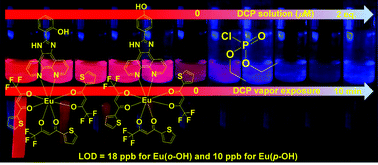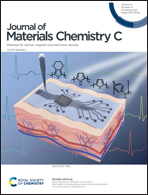Luminescent heteroleptic Eu(iii) probes for the selective detection of diethyl chlorophosphate as a G-series nerve agent mimic in the vapor phase using solid-state films†
Abstract
The extreme toxicity of innocuous organophosphate (OP) nerve agents poses a significant public health risk. Developing an efficient sensing and detection system is crucial to contain and mitigate disasters and strengthen national security. Luminescence spectroscopy offers very sensitive, visually identifiable color changes to enable a low-cost option for the specific detection of nerve agents. Lanthanide ions exhibit unique optical properties due to sensitized f → f transitions over organic fluorophores for developing luminescent optical sensors. Here, we designed two heteroleptic time-resolved luminescent Ln(III)-probes, namely, [Eu(o-HPIP)(TTA)3] ([Eu(o-OH)]) and [Eu(p-HPIP)(TTA)3] ([Eu(p-OH)]), for the selective sensing of the G-series nerve agent simulant diethyl chlorophosphate (DCP). The molecular identity, speciation, and optical properties of the complexes were evaluated using various physicochemical and spectroscopic methods in solution. The solid-state structure of Eu(o-OH) shows an eight-coordinated {LnN2O6} square-antiprismatic geometry. The interaction of the Eu(III) probes with DCP results in selective quenching of the characteristic red luminescence of Eu(III) originating from the 5D0 → 7FJ (J = 0–4) f → f transitions with a limit of detection (LOD) reaching up to the ppb level for DCP {LOD: 18 ppb [Eu(o-OH)] and 10 ppb [Eu(p-OH)]}. Selective luminescence quenching is distinctly perceptible to the naked eye under UV-illumination (λ = 365 nm). The phenyl hydroxyl group was strategically incorporated at the periphery of the HPIP ligand anticipating possible nucleophilic attack at the P–Cl bond of DCP, thereby perturbing the EnT pathway from the ligand to Eu(III). The NMR titration data and the structure of the isolated thermodynamically stable polymeric [Eu(DHP)3]n end-product formed by the reaction of Eu(o-OH) with DCP confirm chemical changes that block the indirect-energy transfer from the o/p-HPIP/TTA antenna to the emissive 5D0 state of Eu(III) causing significant quenching of time-resolved luminescence (TRL) intensity. Vapor phase detection of OP-simulants was attempted using a Eu(III)-probe immobilized on a low-cost filter paper strip. We observed consistent emission quenching of filter paper strips upon exposure to DCP vapors. The changes in Eu(III)-TRL intensity avoid any background autofluorescence and possible photobleaching associated with organic fluorophores. These absorbent paper strips could be developed as a prototype for the selective on-site detection of G-series nerve agents.



 Please wait while we load your content...
Please wait while we load your content...